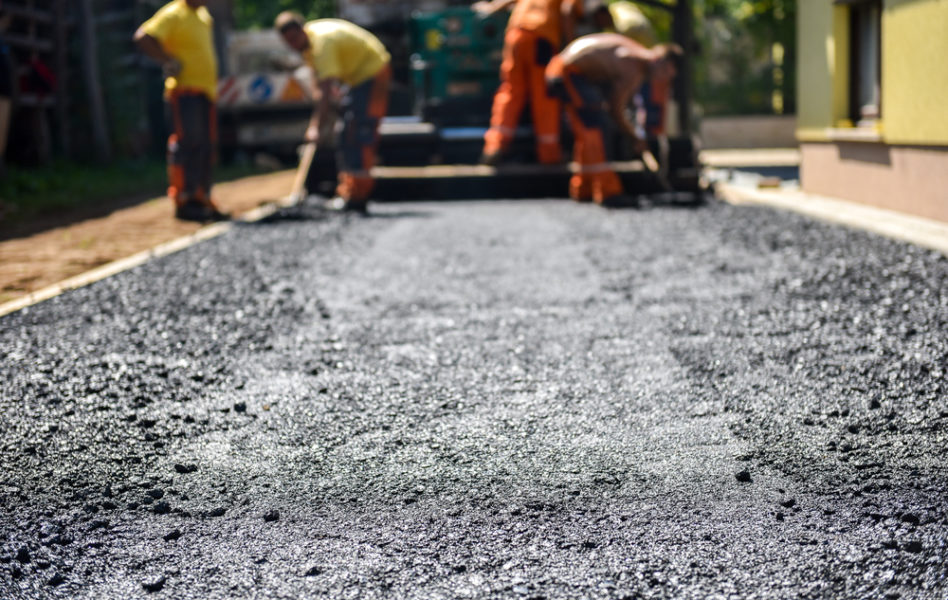Unlocking the Tricks of Warm Mix Asphalt Modern Technology
Checking out the depths of warm mix asphalt modern technology discovers a world where precise solutions and careful processes merge to shape our roads and framework. The combination of aggregates, binders, and fillers isn't just a building job however a strategic orchestration of durability and performance.
Significance of Warm Mix Asphalt
Hot Mix Asphalt plays a vital role in modern-day facilities growth because of its resilience and cost-effectiveness. As one of the most typically made use of paving product for roads, freeways, and parking area, Hot Mix Asphalt supplies a variety of advantages that add to its relevance in building tasks. One essential benefit is its ability to stand up to hefty web traffic lots and severe weather, giving a dependable and durable surface for transport networks. In Addition, Hot Mix Asphalt is economical in both first construction and long-lasting upkeep, making it a preferred option for several infrastructure projects.
The durability of Warm Mix Asphalt stems from its structure, which includes accumulations, binder, and filler products that are thoroughly selected and blended to meet details efficiency requirements. On the whole, the value of Hot Mix Asphalt in framework advancement can not be understated, as it proceeds to be a foundation of modern-day building practices.
Elements of Asphalt Mixes
The structure of asphalt mixes includes thoroughly selected accumulations, binder, and filler products that are essential for attaining certain performance needs. Aggregates are the key element of asphalt blends, offering toughness and security. These aggregates can be all-natural, such as gravel or smashed stone, or synthetic, like recycled products from old pavements. The binder, typically asphalt or asphalt cement, holds the aggregates together and supplies flexibility and longevity to the mix. The choice of the binder is important as it directly affects the mix's performance in different weather. Fillers, such as moisturized lime or Portland cement, are made use of to improve the mix's workability and aging resistance. Angled Parking.
The combination and proportion of these parts play a significant function in figuring out the quality and performance of the asphalt mix. Engineers very carefully design the mix to satisfy particular needs, considering elements like traffic volume, climate problems, and sidewalk lifespan. Proper selection and balancing of aggregates, binder, and fillers are necessary for developing sturdy, long-lasting asphalt sidewalks.
Combining and Manufacturing Methods

Once the accumulations are picked, the binder, frequently asphalt cement, is added to bind the products with each other. The binder's high quality and amount considerably affect the mix's flexibility, resistance, and strength to ecological variables. Additionally, fillers like hydrated lime or Portland cement might be included to enhance specific characteristics of the asphalt mix, such as its workability or moisture resistance.
During manufacturing, the accumulations and binder are warmed, commonly find out here in between 250-325 you can try these out ° F(121-163 ° C ), to facilitate blending and make certain correct coating of the aggregates. The mixing process should be complete to attain an uniform combination that advertises the wanted performance qualities of the asphalt. Various techniques, such as set blending or drum blending, are utilized to accomplish top notch and regular asphalt blends for construction tasks.
Variables Influencing Asphalt Efficiency
Aspects influencing asphalt efficiency incorporate a variety of variables that impact the toughness, longevity, and total quality of asphalt sidewalks. One key aspect is the quality of materials made use of in the asphalt mix.

Environmental problems also affect asphalt performance. Temperature level variants, wetness seepage, and web traffic lots can all affect the architectural integrity of the sidewalk. Design factors to consider, such as sidewalk thickness and water drainage, are necessary in making certain the long-term efficiency of the asphalt sidewalk. By thoroughly taking into consideration these elements, designers and professionals can optimize asphalt performance and improve the life span of sidewalks.
Lasting Practices in Asphalt Innovation

WMA allows for the manufacturing and positioning of asphalt blends at reduced temperatures contrasted to conventional hot-mix asphalt, resulting visit this website in lowered energy intake and greenhouse gas emissions. The usage of porous asphalt mixes can aid reduce stormwater drainage issues by enabling water to penetrate through the sidewalk and right into the ground, promoting all-natural water purification and recharge procedures.
Conclusion
Finally, warm mix asphalt modern technology plays an important function in modern-day framework development due to its toughness and cost-effectiveness. By meticulously stabilizing components, employing proper mixing techniques, and thinking about different aspects, designers can develop high-grade asphalt blends that withstand hefty website traffic loads and harsh climate condition. Embracing lasting practices, such as making use of recycled materials and warm-mix technologies, better boosts the ecological kindness of asphalt innovation.
Mixing and production strategies in warm mix asphalt innovation include the accurate combination and handling of accumulations, binder, and fillers to produce a durable and high-performance asphalt mix.Variables affecting asphalt performance encompass an array of variables that affect the sturdiness, durability, and overall top quality of asphalt sidewalks. Sustainable techniques in asphalt modern technology include various campaigns aimed at reducing the ecological effect of asphalt production and paving procedures. By incorporating reclaimed asphalt sidewalk (RAP) and recycled asphalt shingles (RAS) right into new asphalt blends, the market can considerably lower the usage of raw products and energy, while additionally reducing landfill waste.
WMA permits for the production and positioning of asphalt mixes at reduced temperatures contrasted to traditional hot-mix asphalt, resulting in minimized energy usage and greenhouse gas emissions.
Comments on “Transform Your Building's Landscape with Hot Mix Asphalt Paving Excellence”